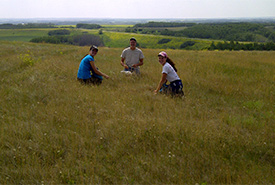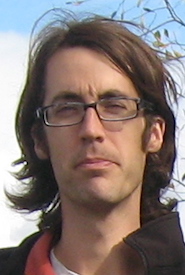Fescue friendship

(L-R) Whitney McNinch, Alex Fisher and Ellen Potts harvest plains rough fescue by hand on NCC`s Maymont 5 property (Photo by Kerry Hecker, Environment Canada)
“If you can’t eat ‘em, pick ‘em!” That’s a saying, right? Well, it is now.
While conducting my first property inspection of the year, I discovered, to my dismay, the fence at Maymont 5 was not going to hold any cows on the property. As with all grasslands in the prairies, this patch of grass in the fescue prairie (a narrow band of a vegetation community between the aspen parkland to the north and the mixed grass prairie to the south where plains rough fescue is an identifying member of the plant community) evolved under heavy grazing pressure from the yearly north-south migration of herds of bison. Without this natural disturbance, many species would not survive. The easiest way to recreate the disturbance is to put some cows on the property, but with no functional fence there would be no way to keep them on the property doing their job of applying that particular natural disturbance on the beautiful riverside property this year.
And what a property! Easily accessible from a paved road and overlooking the North Saskatchewan River, this patch of fescue grassland melds into a mix of aspen, Saskatoon berry, and wolf willow as it stumbles down the breaks, only to end in a quiet little swamp on the river shore.
Picturesque from afar and gorgeous upfront, but what was I staring at? The wind-waving heads of plains rough fescue in bloom. Seeing more and more of it got me more and more excited. This important and iconic prairie grass of the northern prairies does not set seed all that often; maybe once in seven years. It’s tough to find, too, unless you have a big patch of it not likely to get grazed that year. I guess not having a fence in place, which meant I couldn’t graze cattle on the property, was good luck after all! If only I could collect it and use it on some deserving prairie restoration project somewhere. Most restoration projects have to reduce the number of species they include because each species you add greatly increases the cost and complexity. Including some plains rough fescue would give a project a real authentic feel.
Fortunately, for all its roads, Saskatchewan is really a small place and after a few emails and phone calls, I found someone interested with the knowledge and the people-power to collect this unique and very important seed. Kerry Hecker, a restoration biologist with Environment Canada at Last Mountain Lake agreed to visit the property to collect the seed by hand with a crew of trained folks who could tell plains rough fescue (rare-ish) from Kentucky blue grass (what grows on your lawn).
The big bag of seed heads they gathered that day were destined to be grown into seedlings in plugs (roots bundled in a growing medium with a small shoot of green out the top). The plugs will be grown over the winter by SaskPower’s Shand Greenhouse, which uses residual heat from electricity production to help grow trees and shrubs, and now plains rough fescue. The plugs they produce have a much better survival rate than any other method of seeding them.
In the following year these plugs will be inserted into specific parts of a prairie restoration project that otherwise would not have had this moisture-loving, north-slope-dwelling, prairie grass. And what does NCC get out of this? Well, besides a bit of credibility and good karma for spotting and sharing in the bounty, Kerry has agreed to share a portion of the plugs that are produced and help plan where and how to plant them on a piece of formerly cultivated land that NCC is restoring back to native prairie near Punnichy.
Not a bad outcome for a walk along a failed fence.


